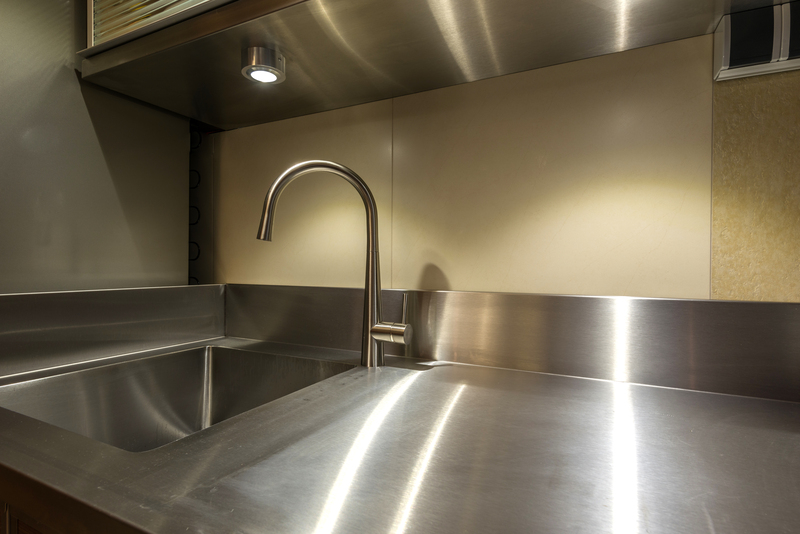Expert Tips for Cleaning Mould from Window Sills
Posted on 03/09/2025
Expert Tips for Cleaning Mould from Window Sills
If you've noticed unsightly black or green spots creeping along the edges of your window sills, you're not alone. Mould on window sills is a common household problem, especially in rooms with poor ventilation or high humidity. While mould might seem like a superficial annoyance, it can lead to health concerns and structural damage if neglected. In this comprehensive article, we'll share expert tips for cleaning mould from window sills, prevention strategies, and frequently asked questions to help you keep your home safe and mould-free.
Why Does Mould Form on Window Sills?
Understanding *why* mould appears on your window sills is the first step to tackling the issue. Window sills are often exposed to condensation, which occurs when warm, moist indoor air meets the cooler surface of the window glass. This creates a damp environment--the perfect breeding ground for mould spores.
- Poor ventilation: Limited airflow can cause moisture to linger, particularly in bathrooms and kitchens.
- High humidity: Humidity levels above 60% accelerate mould growth.
- Leaking windows: Gaps around windows can let rainwater seep in, adding to moisture problems.
- Lack of sunlight: Mould thrives in dark, shady conditions.
Not only is the presence of mould on your window frame or sill unattractive, but it may also trigger allergies and worsen respiratory conditions. That's why it is crucial to address the problem with effective mould cleaning methods and prevent its recurrence.

Health Risks Associated With Window Sill Mould
It's important to recognize the risks posed by continual exposure to mouldy window frames and sills. Mould can release microscopic spores into the air, which can cause a variety of health problems, including:
- Allergic reactions (sneezing, watery eyes, rashes)
- Worsening of asthma or bronchitis
- Headaches or difficulty breathing
- Sinus congestion
Vulnerable groups like children, the elderly, and those with compromised immune systems are particularly at risk. That's why it's essential to keep your window sills clean and mould-free.
Signs You Have Mould on Window Sills
Before you begin with any cleaning technique, make sure what you're dealing with is indeed mould. Here are common signs:
- Dark spots or patches--usually black, green, or brown in color
- Damp or musty smell near the window area
- Peeling paint or bubbling wood around the sills
- Condensation on the inside glass of your windows
If the area seems large or the mould keeps returning despite your cleaning efforts, consider consulting a professional remediation service.
How to Safely Clean Mould from Window Sills
To achieve the best results and protect your health during the cleaning process, gather the right materials and take proper precautions.
Essential Materials
- Rubber gloves
- Protective eyewear or mask (to prevent inhalation of spores)
- Old rags or microfiber cloths
- Soft brush or old toothbrush
- Spray bottle
- Bucket
- Mild detergent or an eco-friendly cleaning solution
- White vinegar or hydrogen peroxide (for deeper cleaning)
- Baking soda (optional, for deodorizing)
Step-by-Step Instructions for Cleaning Mould Off Window Sills
- Protect yourself. Wear gloves, eyewear, and a mask to shield from mould spores.
- Ventilate the area. Open windows or use a fan to ensure good airflow while you work.
- Prepare your solution. Create a cleaning mixture using one part white vinegar to one part water, or use a mild household detergent.
- Spray the affected area. Soak the mouldy section with your cleaning solution and let it sit for 10-15 minutes.
- Scrub gently. Use a brush or old toothbrush to remove mould, working in circular motions. For wooden window sills, avoid abrasive scrubbing as it might damage the surface.
- Rinse and wipe dry. Take a clean, damp cloth to remove the residue and dry the area completely using another dry towel.
- Disinfect if needed. For stubborn stains, apply undiluted hydrogen peroxide, allow it to bubble for a few minutes, then scrub and wipe dry.
- Dispose of contaminated materials. Place used rags and gloves in a sealed bag and throw them away to prevent spreading spores.
Repeat the process if mould persists, but ensure you keep the room ventilated at all times.
Natural Agents for Mould Removal from Window Sills
If you prefer to avoid harsh chemicals, these natural solutions are both safe and effective for cleaning mouldy window sills:
- White vinegar: Kills up to 82% of mould species. Spray liberally and leave for an hour before wiping.
- Baking soda: Mix with water to form a paste for scrubbing stubborn spots and deodorizing the area.
- Hydrogen peroxide (3%): Apply to kill fungal spores. Let it sit for at least 10 minutes.
- Lemon juice: Its acidity helps break down small mould patches and leaves a fresh scent.
- Essential oils (tea tree or eucalyptus): Add 10 drops to 1 cup of water in a spray bottle for added antifungal properties.
Always test a small, inconspicuous area first to ensure there's no staining or damage, especially with wood or painted finishes.
When to Use Commercial Mould Removers
While household and natural remedies are effective for light to moderate contamination, you may encounter stubborn black mould on window frames that requires a commercial cleaner. Look for products designed specifically for mildew and mould removal, and follow the manufacturer's instructions.
Never mix bleach with ammonia or other cleaners, as this can release toxic fumes. If you have a lot of mould (more than a square meter) or if you're dealing with toxic black mould (Stachybotrys chartarum), consult a professional for safe remediation.
Preventing Mould Growth on Window Sills
*Prevention is better than cure*, especially with persistent mould problems. Follow these proactive tips to keep window sills mould-free:
- Reduce condensation: Use double-glazed windows and insulate frames where possible.
- Improve ventilation: Open windows daily, use extractor fans in kitchens and bathrooms, and consider installing trickle vents.
- Use a dehumidifier: Maintain indoor humidity below 60% to discourage spore growth.
- Fix leaks: Check window seals, sills, and nearby roofing for gaps or leaks and repair them promptly.
- Regular inspection: Wipe down sills and frames when cleaning, and look out for early signs of mould.
- Avoid drying clothes indoors: This increases moisture levels in your home.
- Apply anti-mould paint: Use a mould-resistant paint on window sills and frames.
Cleaning Tips for Different Window Sill Materials
Not all window sills are made alike. Here are special considerations for different types of window frames and sills:
- Wood: Be gentle. Don't saturate with water as it may cause warping. Use a slightly damp cloth and dry immediately.
- UPVC: More resilient--can clean mould with diluted bleach (1:10) or commercial sprays.
- Painted surfaces: Avoid abrasive scrubbing. Use a soft cloth with vinegar or mild detergent.
- Stone or tile: Use any standard mould remover or natural solutions; rinse thoroughly and dry.

Frequently Asked Questions about Mould Removal from Window Sills
Is it safe to clean window sill mould myself?
*Yes*, if the affected area is small (usually less than one square meter), and you use the right personal protective equipment. However, for large areas or persistent toxic black mould, it's best to hire a professional.
How often should I clean my window sills?
Wipe down and inspect your window sills at least once per week, and deep clean monthly or whenever you see visible mould.
Can I use bleach on window sills?
Bleach is effective at killing mould on nonporous surfaces like UPVC. However, it shouldn't be used on wood as it can damage the finish and won't penetrate deep enough to kill hidden spores. Vinegar or hydrogen peroxide is safer for wood.
Why does the mould keep coming back?
If mould returns persistently, the underlying moisture problem is unresolved. Address sources of condensation or leaks, and keep humidity levels low.
Can mould on window sills affect indoor air quality?
Absolutely. Mould releases spores that degrade air quality, leading to health problems over time. That's why regular window sill mould removal is so important.
Conclusion: Swift Mould Removal for a Healthier Home
Tackling window sill mould doesn't have to be overwhelming. Armed with these expert cleaning strategies, you can efficiently eliminate unsightly and potentially harmful mould patches. The key to success is: prompt action, the right cleaning tools, and consistent prevention measures. Clean your window sills regularly, keep moisture in check, and your indoor air will be cleaner and healthier.
If you found this article helpful, share it with neighbours or family facing similar issues. For more home cleaning guides, be sure to bookmark this page and check for updates on the latest mould removal tips and solutions.




